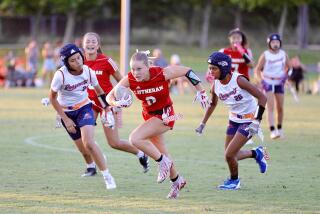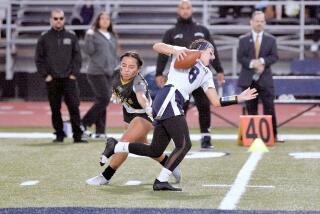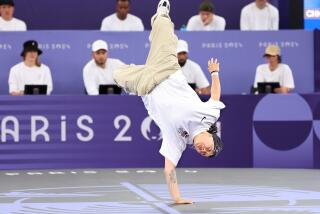Swashbucklers’ Swords Cross in Prelude to 1987 Junior Olympics
- Share via
Swords clashed sharply at Los Angeles Valley College’s Women’s Gymnasium in Van Nuys on Sunday. Scoring boxes sounded high electronic tones and judges called out “Touch!” as some 50 fencers under the age of 20 competed in several events at the Junior Olympic Qualification Tournament.
“Fencing has that swashbuckling look to it, like the old Errol Flynn movies, yet it’s so different when you actually get seriously into the sport,” observed Edward Francis, 31, a Newbury Park fencer.
Since the 1984 Olympics, fencing has enjoyed a renaissance, and the centuries-old martial art is popular among all age groups in the Valley. Of the 22 who qualified Sunday for the Junior Olympics to be held in Orlando, Fla., next February, 10 are residents of or attend Valley schools.
“I’m not the type of person who likes team sports,” said Graham Golkin, 16, who won gold medals in two divisions. Rated seventh in the country last year in the under-17 division at the Junior Olympics, the straight-A student attends Cal Prep, a private school in Van Nuys. Golkin began fencing when he was 12, and competes in the sabre, a slashing weapon. He is now a student of Robert Randolph, whose fencing club Salle Grenadier meets Tuesday evenings at Valley College.
“Every single medalist in the sabre event last year in all categories--men, women, adult, junior, team, and individual--were my fencers,” said Randolph. For seven straight years Salle Grenadier has held the Western United States championship.
Randolph took up fencing at USC in 1975 and formed his own club in the late ‘70s. Twenty Grenadiers, seven of them women, attend lessons at least once a week and more often during the championship season, which runs March to June.
Pacific Coast champion Gherman Zilbershteyn, 23, of Sunland, fences for the Grenadiers, although he no longer takes lessons. “I’m OK,” the Russian-born fencer said modestly. “When I’m national champion, then I’ll be good.”
Most of the Valley winners at Sunday’s junior trial are the students of Ted Katzoff, master-at-arms and founder of Salle Gascon, the resident club of the West Side Fencing Center. Katzoff, 43, began fencing when he was a 12-year-old actor and his parents wanted him to spend his one day off doing something active. It grew on him. Now he teaches fencing at the center in Culver City, at UCLA, and at two private secondary schools in North Hollywood: 16 students at Oakwood and 50 at Harvard.
“There’s a general feeling among fencers throughout the United States of the importance of juniors,” said Katzoff.
Before novices are allowed to fence in competition, many instructors insist they drill for many months. “It’s not like basketball, where you learn it and go out and play,” explained Karen Westbrook, a 32-year-old Newbury Park purchasing agent who has been fencing for 2 1/2 years. “It takes years. And we’re in a fast food kind of world. That’s why a lot of people start and then quit.”
Chris Kinnear, 14, of Pasadena fences three times a week as part of his physical education program at Oakwood School. “I like it because it’s individual,” he said. “There’s no one to blame you for your actions. I’ve been on football teams, and if you’re not a great player people get really mad at you. Not many people at this school are interested. Somehow there’s an association with fencing being a nerd’s kind of sport, for wimps and stuff. That bothers the stud lettermen.”
Fencers are hardly wimps; modern fencing is descended from a deadly form of combat.
Sean Flaherty, 28, a junior high school teacher who lives in Westlake, first took up fencing when he was 18, because he had the “typical little kid fantasies based on the movies,” he said.
‘Seems Sort of Exotic’
“Most people have the same illusion that fencing is dangerous, or it seems sort of exotic to them,” said Flaherty. “It’s not the kind of sport everyone wants to pick up, but those that do, don’t let it go.”
He said fencing is multifaceted. “It has the discipline of a martial art. It also has an internal side to it. There is something in there that can’t really be taught but it can be observed.”
Flaherty’s instructor at the Conejo Fencing Club, Duris de Jong, compares fencing to chess. “Fencing is very much of a cerebral sport. it’s like chess. Anyone can learn the movements, how to move the chess pieces. Fencing’s here,” he said, tapping his head.
“Thinking, imagination, feeling out the opponent, timing. If you don’t have the reflexes, you will never be a fencer. You can have all the technique in the world, and you’ll still never be a fencer.”
De Jong’s classes, which meet three times a week at the Conejo Community Center in Thousand Oaks, attract students from a wide area. The lively 84-year-old brings with him a professional fencing background that includes competition in the 1928 and 1932 Olympics, where he reached the finals. Only a hip replacement operation a year ago stopped him from adding to his collection of 300 medals and trophies.
Age No Major Factor
“Age doesn’t make that big a difference in fencing,” said De Jong.
He believes a fencer should start at age 4 or 5 and that it takes five years to learn the technique. Other instructors have suggested the age of 8 or 9 as the youngest to begin. Two 12-year-olds competed at the Junior Olympic trials.
Most of de Jong’s 20 students are adults, many of whom show up at every class. Even pain caused by the physically demanding sport does not stop them.
“I’ve always got an ache or a pain in one place or another,” said Phillip Hareff, 36, of Moorpark. “I keep playing. You have to--De Jong doesn’t understand when I tell him I have a hurt leg or a pulled muscle. Maybe you only give 50%, but you show up and try to help the younger people coming along.”
Karen Westbrook is one of three women taking lessons from De Jong. She was always intrigued by the idea of fencing and read that women could do it also. The thought remained in the back of her mind until she heard of classes being given locally.
“All my friends think I’m pretty crazy,” she said with a big smile.
Gain Equal Footing
Many people find in the sport their first opportunity to be on an equal footing with others. “For those of us who washed out of lots of other sports in school, fencing is great,” said Phyllis Elliot, manager and assistant coach at the West Side Fencing Center. “Fencing makes an athlete out of you. In a way, everyone starts as equals since you use muscles you haven’t used for anything else.”
The possibility of camaraderie amid competitiveness is attractive to many fencers. Arline Golkin, who helped at the Junior Olympics in which her son participated, mentions the overall pleasantness of the youngsters.
“They’re neat kids. They are unusually helpful to each other in that they warm each other up and work together when they’re not on the strip competing.”
Fencing is also just plain fun. As Flaherty pointed out, “You get in there, you put a mask on, and it doesn’t matter what you look like. It comes down to ability, a sort of dance between two people.”
Related story, Page 11.
More to Read
Go beyond the scoreboard
Get the latest on L.A.'s teams in the daily Sports Report newsletter.
You may occasionally receive promotional content from the Los Angeles Times.






